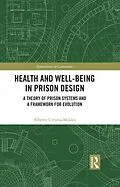This book establishes a new framework for prison design to promote the health and well-being of all prison users. Based on international research in Norway, Finland, the USA, and Chile, and drawing on the expertise of key international advisors, this book uniquely reveals the perspectives of both designers and prison authorities concerning well-being in prison architecture. It is the first book to compare perspectives between prison models while providing essential guidance for the design of prison environments to promote the rehabilitation of inmates and their desistance from crime.
The promotion of health and well-being of people in prison is vital to enable rehabilitation. Traditional prison architecture severely weakens both rehabilitation efforts and opportunities for desistance. Only a handful of prison systems in the world have shown significant changes in their prison designs. Underpinned by Critical Realism and the PERMA theory of well-being, this book reveals significant new insights to inform prison design. The author presents international case study research with interviews with prison authorities and designers from four countries and the three different prison models, as well as key international United Nations advisors. For the first time the visions of prison designers are contrasted with those of prison authorities, bringing a new synthesised understanding of the differences and similarities in their approach to the health and well-being of both inmates and staff from which to generate a new framework for design considerations.
This book illuminates new directions for prison design and is essential reading for policymakers, academics, and students involved in the study and development of criminology, corrections, and penology. It is also an indispensable source of up-to-date knowledge for prison authorities, public health officials, architects, and designers involved in the design of prisons and any other type of coercive detention facilities.
Autorentext
Alberto Urrutia-Moldes holds a PhD in prison architecture from the University of Sheffield in the UK. He also has a BSc in Industrial Engineering (2008) and a BSc in Construction Management (1993), both from the University of the Bío-Bío in Chile. After graduating as Construction Manager, he started working in the construction industry for private companies until 1998, when he was appointed head of the regional office of infrastructure at the Bío-Bío Regional Directorate of the Chilean prison service in the city of Concepción. In this capacity, Alberto was responsible for addressing the needs of the 24 prison and parole facilities across 14 cities in the Bío-Bío region. He was later appointed as the head of the projects and planning office at the same regional directorate. In tandem with his job in the Chilean prison service, he has worked since 2006 as a part-time lecturer in construction management at the School of Construction Engineering at the University of the Bío-Bío. In 2012 he co-organised - with the Faculty of Architecture at the University of the Bío-Bío - the first conference in prison architecture held in Chile, and then co-edited the book 1st Seminar of Prison Architecture for Social Reinsertion, which contains the main presentations of the two-day conference. In 2014 he moved to the UK, where he started his PhD programme, being awarded a Doctoral degree in March 2020.
Inhalt
Introduction
What is this book about?
Why Health and well-being in prisons?
The relation between health and well-being
The challenge of health and well-being in prisons
Structure of this Book
PART I: THEORETICAL AND HISTORICAL FOUNDATIONS
Chapter 1: Theoretical standpoints
The roots of well-being
Seligman's theory of well-being
Critical Realism: a theoretical lens to understand imprisonment
Chapter 2: Punishment and prison design
Ethical considerations in prison design
The justifications for punishment
Building a typological theory of prison systems
Chapter 3: Evolution of prison models from the birth of the prison to the nineteenth century
From late antiquity to the prison reform
The birth of the Security prison model: Nineteenth-century prison reform in the US
Scandinavian Repressive system before the Rehabilitation prison model
Latin American prison development and the Repressive roots of its Hybrid model
Chapter 4: Prison models: recent history, and development from the twentieth century to the present
Prisons designed for behavioural change
Safety prison model development
The Rehabilitation, prison model's consolidation
Hybrid prison model in Chilean and Latin American prisons in the twentieth century to date
PART II: HUMAN FACTORS AND THE IMPORTANCE OF THE HEALTH AND WELL-BEING OF PRISON USERS
Chapter 5: Why should prison design promote health and well-being?
The role of health and well-being in prisons and prison design
International concerns related to health and well-being in prison
Latest developments in prison architecture research
Chapter 6: Environmental stressors to health
Physical environmental stressors
Psychological environmental stressors
Summary of findings
PART III: CASE STUDIES FROM THE HYBRID, THE SECURITY, AND THE REHABILITATION MODELS
Introduction to Part III
Chapter 7: International Advisors
Prison Policy Advisors
Prison Health Advisors
Comparative analysis between both groups
Key emerging themes and Meta-themes
Chapter 8: The Hybrid prison model
Chilean prison design in the context
Analysis
Thematic areas emerging from High-level Staff interviews
Thematic areas emerging from prison designers' interviews.
Key emerging themes and Meta-themes
Chapter 9: The Security prison model
Prison design context in the US
Analysis
Thematic areas arising from High-level Staff interviews
Thematic areas emerging from Independent Designers' interviews
Key emerging themes and Meta-themes
Chapter 10: The Rehabilitation prison model
Prison design context
Analysis
Thematic areas emerging from High-level Staff interviews
Thematic areas arising from Governmental Designers' interviews
Thematic areas emerging from Independent Designers' interviews
Key themes emerging from the Rehabilitation prison model
PART IV: TOWARDS A NEW OUTLINE FRAMEWORK FOR PRISON DESIGN
Chapter 11: Cross-case comparison of prison models
Summarising and organising individual case findings
Cross-case comparison among High-level Staff
Cross-case comparison among designers
How and why are some issues ignored?
Chapter 12: Towards a new outline framework to design prisons that promote health and well-being
Building the new outline framework for prison design
Organised hypocrisy in prison services
Recommendations for promoting health and well-being in prison design.
Appendix A
Appendix B
Appendix C
References
